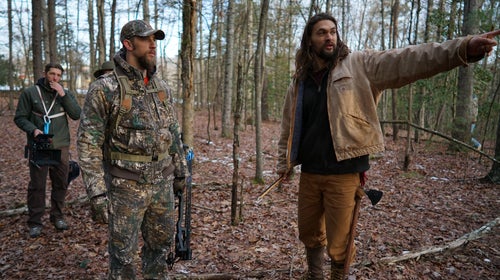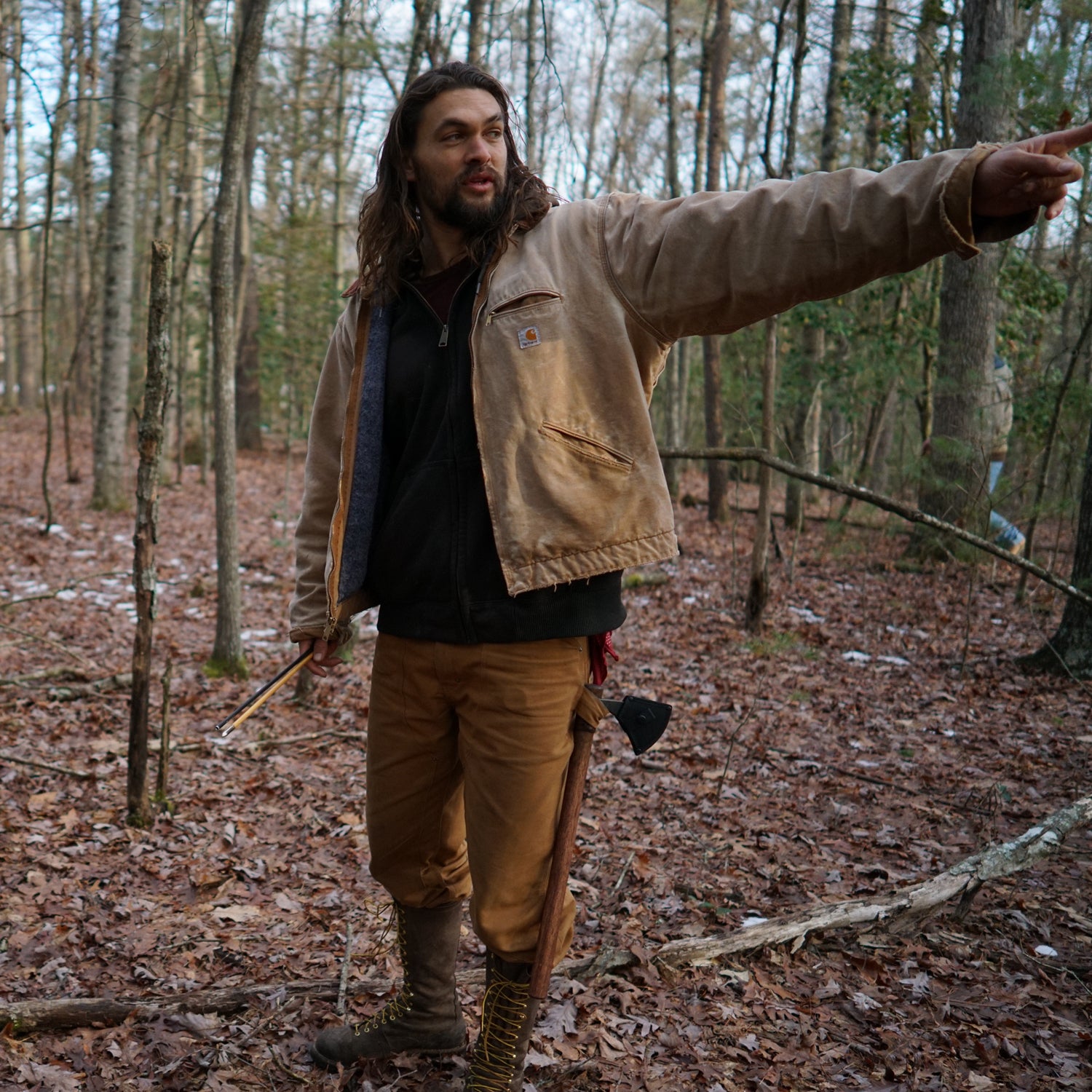It's not prime tourist season in Marine Park, a 1,100-acre campground and waterpark in the municipality of Pouch Cove, Newfoundland. Like a cruel joke, the park’s giant waterslide towers over a frozen lake, where the ice looks thick enough to withstand a monster truck rally. There are no garish vehicles currently on the premises, but nearby, a different kind of carnage is imminent.
Jason Momoa—the actor most well known for his role as the equestrian warlord Khal Drogo in season one of Game of Thrones—gets into a crouching position behind his cameraman at the far end of an elaborate reconstruction of a World War I combat scene.
“Smoke it up!” Momoa yells.
A crewmember in a Pittsburgh Steelers hoodie walks the length of a massive trench wielding a portable smoke machine, like a thurifer tasked with the grim responsibility of spreading the fog of war. Still crouching, Momoa calls out, “Here we go, boys! Five, four, three, two, one . . . ACTION!”
A second later, I feel a wave of heat from an explosion in no man’s land, a fireball just beyond the edge of the trench. A soldier carrying a Spandau MG-08 hurtles through the gully. An exuberant Momoa follows, yelling “Go, go, go.” Another explosion fills the grey sky with bits of Newfoundland soil, which rain down on those of us standing in the peanut gallery. Young men wearing the doughboy uniforms of U.S. Expeditionary Forces—Brodie helmets, tunics, and canvas spats—climb out of the trench and take up combat positions behind sandbags and gnarled piles of broken timber.
“I just kept getting called in for these action movies. One-liner, guy doesn’t say much, shoots a bunch of shit. I was like, ‘That ain’t me.’ ”
The soldier nearest to where I’m standing exudes particular menace as he fires his weapon at an imaginary foe. I learn later that the actor is none other than legendary Canadian raconteur and NHL first-round flop Terry Ryan, known for exploits like smashing out several of his own front teeth with a hammer.
Ryan never seems to break character, even when the camera stops rolling. This is probably a wise move, as Momoa promises swift retribution for anyone who accidentally ruins a scene with an errant facial expression. “If you smile, you’re getting slapped!” Momoa yells out, grinning, before another take.
https://youtube.com/watch?v=ImA817cEhjQ
Momoa, who got his start on Baywatch Hawaii in 1999, has plenty on his schedule for the next few years. Most notably, he’ll embody the DC superhero Aquaman alongside Batman, Superman, and Wonder Woman in at least three upcoming Justice League movies, the first of which just began filming in London. So why is he orchestrating a World War I reenactment in the middle of nowhere? The simple answer is that he’s directing a commercial for workwear manufacturer Carhartt. The company chose Newfoundland as its shoot location partly because Momoa was already there, starring in another film called Braven. (He plays a logger and family man who runs afoul of some drug runners. Guess what happens next.)
What Momoa is really trying to do is make a career for himself beyond acting, where he's usually typecast in the way that's lead so many action stars to . He wants to establish himself as a legitimate filmmaker, too. While directing a few TV commercials will hardly turn anyone into Orson Welles, Momoa views his Carhartt collaborations as something of an apprenticeship.
His own Citizen Kane is already in the works, and he needs to be ready.
Later that afternoon, I sit in a sparsely furnished RV with Momoa, drinking Guinness and trying to thaw my fingers. He explains that the violent scenes he’s been known to play a starring role in are not necessarily reflective of his personal taste.
“I was raised by a single mother in Iowa,” Momoa says. “We weren’t watching orgies with guys getting their heads lopped off. I was watching Rear Window and Gone With the Wind.”
Somehow, it’s not easy to picture the six-foot-four Momoa—who is wearing a “Carhartt Beer Society” hoodie and whose face bears a scar from an unfortunate collision with a pint glass a few years back—smitten with Scarlett O’Hara. Those familiar with Momoa’s career will know his reputation for playing the kind of characters you wouldn’t want to get in a fight with or have on your team in a spelling bee. Before he was Khal Drogo, Momoa landed the lead in Conan the Barbarian, a 2011 remake of the early ‘80s Schwarzenegger gore fest.
“I’m just in this larger-sized body and people kind of hire me to do that,” Momoa says. “That” refers to scenes of extreme ass-kicking, whether it’s the part in Game of Thrones where he , or the denouement of Bullet to the Head, in which his character tries to annihilate Sylvester Stallone with an axe before (spoiler alert) taking a bullet to the head.
Such roles never quite did it for Momoa, who, at 36, harbors loftier artistic aspirations that his cinematic resume might imply. “I just kept getting called in for these action movies,” Momoa says. “One-liner, guy doesn’t say much, shoots a bunch of shit. I was like, ‘That ain’t me.’” Like his mother, he is a painter, with two shows to his credit. In the brief time that I spend with him, he references Caravaggio’s work and compares Detroit’s current bohemian vibe to what once drew aspiring artists to Berlin. Momoa also credits his mom for another lifelong passion: climbing. He's been hooked since she took him rock climbing in South Dakota one summer when he was a teenager, and he's talked about plans to open his own climbing gym.
“I was raised by a single mother in Iowa. We weren’t watching orgies with guys getting their heads lopped off. I was watching ‘Rear Window’ and ‘Gone With the Wind.’ ”
In an effort to do projects that were more “him,” Momoa started his own production company, , in 2010. In July 2014, the company released its first feature length film, Road to Paloma, about a man who avenges his mother’s death and then goes on the lam, with her ashes in tow. The company’s next step was to seek potential corporate clients. Momoa, as a child of the rural Midwest, says there was only one brand that he really wanted to work with.
“Carhartt was it,” he says. “Growing up, I skateboarded in it. I played hockey in it. Everything.”
The Detroit-based manufacturer was skeptical at first—nobody knew exactly who he was or why he wanted to make commercials for them.
“We were like, who is this guy? Wasn’t he on Baywatch? ” Carhartt creative director Brian Bennett told me. But Momoa kept calling. Finally, Bennett agreed to meet Momoa for beers in Detroit. They hit it off right away, bonding over a common working class background and a shared appreciation for the film adaptation of Jean-Dominique Bauby’s memoir, The Diving Bell and the Butterfly. Pride of Gypsies has since collaborated with Carhartt on seven film projects, including depicting red-blooded American men—like MLB pitcher Madison Bumgarner—hard at work.
The current shoot is part of Carhartt’s most ambitious ad campaign to date: a chronological progression of set pieces depicting iconic moments in blue collar America, along with an item of Carhartt clothing worn at the time. Scenes include “Building the Railroad” (pinstripe denim overalls); “Iron Workers Building a Skyscraper” (denim jacket); “Construction of the Alaska Pipeline” (snorkel parka). The most involved of these historical recreations is the World War I trench scene, a nod to the fact that American soldiers wore Carhartt pants.
“It’s a fucking huge, ambitious, action-oriented commercial,” Momoa says. “Recreating all these times and places… Doing that and being trusted by these guys is practice for me to do independent movies of my own.”
I ask Momoa what makes a good director. He says it’s about building trust with actors.
“You’ve got to be in the trenches with them,” Momoa says, taking another swig of Guinness.
That night, the crew gets together for sushi in St. John’s, Newfoundland’s capital. Snow is forecast for tomorrow, and there’s hope that today’s trench scene will look even better when re-shot with everything coated white.
Momoa has had a few more beers since our conversation in the trailer. I don’t see exactly what happens—so I don’t know whether it’s intentional or just a consequence of his hugeness—but suddenly a there’s a broken chair on the floor in Momoa's immediate vicinity. We inform the waitress, and it becomes immediately obvious that this isn’t the first time the Pride of Gypsies crew has eaten here. “Why am I not surprised?” she asks.
Among those seated at the table is Utah-based master alpinist and Hollywood trainer , who’s getting Momoa in shape for his upcoming role as Aquaman. (As a climbing fanatic, Momoa has been a Twight fan for years.) Twight says that as long as he can keep Momoa’s daily beer consumption in the single digits, they should be okay. I don’t know if he’s being facetious.
I ask Momoa how he feels about such big-budget Hollywood roles that outfit him with celebrity personal trainers, versus smaller more intimate projects, like a Carhartt shoot in the tiny easternmost town in North America. He says that he’s grateful for the financial cushion of the big movies, but even if the money weren’t there, he’d still be doing the things he wants to do.
As soon as he’s done being Aquaman, Momoa says, he will get his crew together to make his magnum opus: a period piece set in late-19th-century Hawaii. Momoa, whose father is of native Hawaiian descent, was born in Honolulu and remains very connected to his early home. He’s been an of the ongoing Thirty Meter Telescope project, which proposes to build a giant telescope atop the Big Island’s Mauna Kea volcano, a site considered sacred by many natives. His upcoming epic is Momoa’s way of showing more support for indigenous Hawaiians: the film will tell the story of Ko’olau and Pi’ilani, two lovers whose world came undone with the U.S. annexation of the islands.
It’s a project that’s been five years in the making. Momoa, who’s been frustrated in the past by a lack of creative control over the films he’s been involved in, says he hopes to be fully responsible for every aspect of the film, “like a painting or a song.”
“I want to be able to say, ‘These are the people I hired, this is what I set out to make.’ And it’s hard to get it distributed the way that you want it to, but I want to fight for that until I get that movie where it’s like, this is my Braveheart,” Momoa says. “At some point when I’ve done enough, I can say: ‘This is the one.’”


